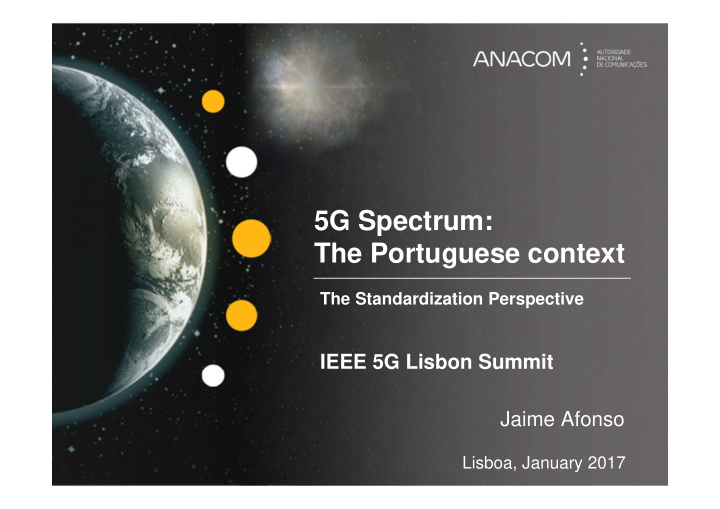



5G Spectrum: The Portuguese context The Standardization Perspective IEEE 5G Lisbon Summit Jaime Afonso Lisboa, January 2017
5G SPECTRUM The Portuguese context Agenda 1. Background 2. 5G challenges 3. Conclusions 2
1. BACKGROUND 3
The “capacity crunch” More spectrum: between 1340 and 1960 MHz Contiguous spectrum and large blocks (currently < 6 GHz) In Portugal: around 1000 MHz allocated spectrum Radio Spectrum Policy Programme: targeting 1200 MHz 4
Mobile Spectrum Terrestrial systems for electronic communications services Or…IMT-2020 Or.. “5G” Relevant Radio Regulations Footnotes Spectrum Bands (MHz) IMT 450 ‐ 470 5.286AA 694 ‐ 790 5.317A 790 ‐ 960 5.317A 1 427 ‐ 1 452 5.341A 1 452 ‐ 1 492 5.346 1 492 ‐ 1 518 5.341A 1 710 ‐ 2 025 5.384A, 5.388 2 110 ‐ 2 200 5.388 2 300 ‐ 2 400 5.384A 2 500 ‐ 2 690 5.384A 3 300 ‐ 3 400 5.429A 3 400 ‐ 3 600 5.430A, 5.432A, 5.432B, 5.433A 5
Wireless Broadband: Portugal in the EU Digital Agenda objectives ( Agenda Portugal Digital ) LTE development Assigned spectrum Source: European Commission 6
Spectrum awards in Portugal BWA auction (2010): 3.4-3.8 GHz (9 regions, 4 blocks) Mutiband auction (2012) Band Number of Lots 450 MHz 1 lot of 2 × 1.25 MHz MHz / band 450 MHz 800 MHz 6 lots of 2 × 5 MHz 800 MHz 1% 15% 2.6 GHz 900 MHz 48% 5% 900 MHz 2 lots of 2 × 5 MHz 1800 MHz 9 lots of 2 × 5 MHz 1800 MHz 1800 MHz 3 lots of 2 × 4 MHz 29% 2,1 GHz 2% 2.1 GHz 2 lots of 5 MHz 2.6 GHz 14 lots of 2 × 5 MHz 2.6 GHz 1 lots of 25 MHz 2.6 GHz 1 lots of 25 MHz around 400 MHz auctioned spectrum : 25% not awarded 7
Spectrum assigned in Portugal Different mobile systems are implemented (GSM, UMTS, LTE) Flexible use of the spectrum Technical conditions (LRTC) based on BEM (Block Edge Mask) Implemented in the 3,5 GHz, 2.6 GHz, 800 MHz and 2.1 GHz bands 8
2. 5G CHALLENGES 9
5G capabilities and use cases IoT ( Internet of Things ): M2M, NFC, RFID, USN, MTC, WASN, Smart***.. The use cases Different requirements Source: ITU-R Rec. M.2083 10
EU initiatives “Gigabit society”- availability and take-up of very high capacity networks, which will enable the widespread use of products, services and applications in the digital single market: 2025 target date Action Plan for “5G” 2025: uninterrupted 5G coverage for all urban areas and major terrestrial transport paths 2020: 5G connectivity to be available as a fully-fledged commercial service in at least one major city in each Member State 11
The next steps for 5G spectrum EU focus: “C band”: 3.4-3.8 GHz 26 GHz WRC-19 “5G” (> 24 GHz) Mobile Agenda item (1.13) Allocation 24.25 ‐ 27.5 GHz (MS) 31.8 ‐ 33.4 GHz (no MS) 37 ‐ 40.5 GHz (MS) 40.5 ‐ 42.5 GHz (no MS) 42.5 ‐ 43.5 GHz (MS) 45.5 ‐ 47 GHz (MS) 47 ‐ 47.2 GHz (no MS) 47.2 ‐ 50.2 GHz (MS) 50.4 ‐ 52.6 GHz (MS) 66 ‐ 76 GHz (MS) 81 ‐ 86 GHz (MS) Protect existing uses (fixed, satellite, passive, SAP/SAB,..) Spectrum sharing (LSA?LAA?CR?) 12
13 3. CONCLUSIONS
Conclusions 5G spectrum: spectrum above 6 GHz and …below Harmonized, contiguous and large bandwidths needed Machine-to-Machine spectrum requirements The strategy for the 700 MHz band Cognitive technology and new sharing solutions Spectrum should also be made available for specific areas, e.g. Galileo, GMES, PPDR, RFID, PMSE Standardization and global harmonization is key 14
THANK YOU! 5G Spectrum: the Portuguese context The Standardization Perspective IEEE 5G Lisbon Summit Lisboa, January 2017 15
Recommend
More recommend